|
Dispatches
- J.B. Russell in Pakistan
|
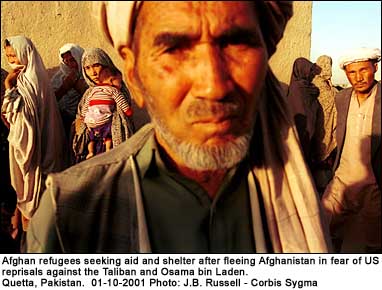 America's
New War on Terrorism Finally Begins America's
New War on Terrorism Finally Begins
President George Bush says that some of this new, first war of the 21st
century will be seen and some of it won't. For those of us who jumped
on the first plane to Pakistan in the initial days after the terrorist
attacks on the World Trade Center and the Pentagon, it has been a long
wait for the visual part of this war to begin. Even if now that it has
begun, no one can see it.
ince landing in Islamabad and coming to the dusty, isolated, southwestern
town of Quetta a month ago, the standard photographic fare has been
the demonstrations and rallies held several times a week by Pakistan's
extremist religious political parties that support the Taliban and Osama
bin Laden in Afghanistan. These protests have been very volatile and
visual, somewhat akin to a revival meeting, but like the religious far
right in the US, these parties and their followers are a boisterous
minority in Pakistan. Hundreds of people gather, various Mullahs yell
the standard anti American insults and the twisted islamic extremist
propaganda. The crowd, at regular intervals get up, scream Allah-o-akbar
and wave banners and images of Osama bin Laden. Then for the grand finale
the Mullahs call for a holy Jihad, the obligatory effigy of George Bush
and several American flags are burned, everyone goes ape shit and then
they go home. After covering numerous of these rallies they seem to
become theatrical. However Afghanistan, where the real story is being
played out is off limits and out of sight.
Baluchistan, where Quetta is located, is a remote, arid corner of southwestern
Pakistan near the Afghan border. It is dominated by tribal areas with
a reputation for violence and smuggling. Due to the tenuous situation,
local authorities require all forgein journalists to be escorted by
an armed guards in order to protect "our valued guests." Although
a bit inconvenient at times, it did not pose much of a problem during
the past few weeks as I covered the demonstrations, did stories on the
building refugee crisis, the Madrasa islamic schools from which the
Taliban movement was born, the problems of drug addiction on the doorstep
of the worlds largest exporter of heroin and a variety of stories in
this checkered town.
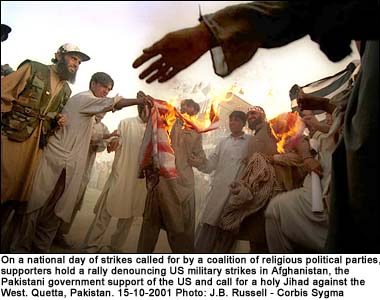 When
the reprisal bombings finally started the demonstrations here in Quetta
suddenly turned violent. Our hosts immediately locked down the hotel
compound effectively detaining the entire press corps under house arrest
in a four star prison. As demonstrators rampaged through the town burning
several banks, two cinemas that show American movies and the UNICEF
office, the police officers at the hotel found themselves fending off
a rebellion of journalists attempting to escape the hotel in order to
do their jobs. In frustration at the end of the day, several of us rushed
the guards en masse and jumped the hotel wall. This created quite a
scene, but allowed us to negotiate an escorted tour of the rampage aftermath. When
the reprisal bombings finally started the demonstrations here in Quetta
suddenly turned violent. Our hosts immediately locked down the hotel
compound effectively detaining the entire press corps under house arrest
in a four star prison. As demonstrators rampaged through the town burning
several banks, two cinemas that show American movies and the UNICEF
office, the police officers at the hotel found themselves fending off
a rebellion of journalists attempting to escape the hotel in order to
do their jobs. In frustration at the end of the day, several of us rushed
the guards en masse and jumped the hotel wall. This created quite a
scene, but allowed us to negotiate an escorted tour of the rampage aftermath.
The next day, after much negotiation, we managed to leave the hotel
to work. At the end of the day myself and several other photographers
were in Kuchlak, a small town near Quetta, where there had been an incident
earlier in the day. Demonstrators had ransacked the village and attacked
a police post. In the mêlée police shot and killed three
protesters, including a 14 year old boy. As we photographed the families
grieving over the victims, the police who had escorted us there for
our protection suddenly became aggressive and began physically forcing
us to leave. As we retreated, the situation degenerated and the police
forces that had previously been overly concerned about our personal
safety turned violently against us. French photographer Patrick Adventurier
of the Gamma agency and Vincent Laforet of the NY Times were beaten
by the police. Paula Bronstein of Getty images and myself were manhandled
and all of us had equipment damaged.
In the end no one was seriously hurt, but the tension has been turned
up several notches since America's new war on terrorism has begun in
a tangible way. The entire world and the journalists covering these
events are walking a very fine line. Quetta, 10-10-2001
Quetta, Pakistan. 12 October 2001
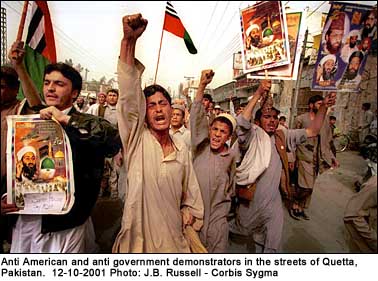 Friday,
the day of prayer in the Islamic world. In Pakistan it is the day of
piousness and then demonstrations. For several weeks now, after Friday
prayers thousands of men have poured out of mosques, whipped into a
frenzy by hard line Mullahs, to protest the anticipated US attacks on
Afghanistan. Today is the first Friday since the US attacks began. Following
the violent demonstrations that took place the day after the first US
bombings, President Pervez Musharraf declared that all demonstrators
that damage property, break the law or incite violence would be shot. Friday,
the day of prayer in the Islamic world. In Pakistan it is the day of
piousness and then demonstrations. For several weeks now, after Friday
prayers thousands of men have poured out of mosques, whipped into a
frenzy by hard line Mullahs, to protest the anticipated US attacks on
Afghanistan. Today is the first Friday since the US attacks began. Following
the violent demonstrations that took place the day after the first US
bombings, President Pervez Musharraf declared that all demonstrators
that damage property, break the law or incite violence would be shot.
From early morning there was a huge security presences in the streets
of Quetta. Military, APCs, heavily armed police forces and even a small
cavalry of policemen on horseback patrolled the streets. Around 2:00
PM the call to prayer echoed from the spires of mosques throughout the
city and the faithful laid down their mats and bowed in worship to Allah
and his prophet Mohammed, all under the watchful eye of the security
forces and the world's media. In a matter of minutes after the prayers
ended, large numbers of young men began to run through the streets yelling
angry protests and waving banners. The crowds swelled and, followed
closely by police, ran toward a large stadium area for an enormous rally.
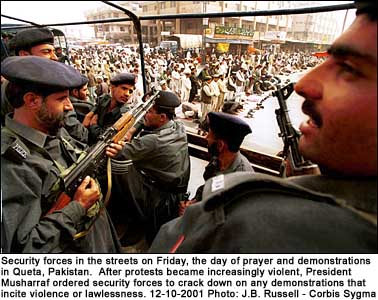 Several
hours of speeches by a long line of bearded, turbaned Mullahs followed.
Each one denounced the US, its allies, and the government of General
Musharraf. They called for national strikes, volunteers to go fight
along side their Taliban brothers and the inevitable Jihad, or holy
war. As the sun began to set into a dusty haze, the habitual effigy
of President George Bush was descended before the crowd. The handlers
had trouble getting it lit and the crowd couldn't contain themselves.
They beat and ripped the figure to shreds before it could be burnt and
then went wild. Crowds surrounded many of the foreign journalist some
throwing stones and aggressively pushing toward them. The private security
forces of the Jamiat Ulema Islam (JUI), the extremist religious political
party that organizes most of the anti American demonstrations, quickly
corralled the journalists and escorted us to our cars. Several
hours of speeches by a long line of bearded, turbaned Mullahs followed.
Each one denounced the US, its allies, and the government of General
Musharraf. They called for national strikes, volunteers to go fight
along side their Taliban brothers and the inevitable Jihad, or holy
war. As the sun began to set into a dusty haze, the habitual effigy
of President George Bush was descended before the crowd. The handlers
had trouble getting it lit and the crowd couldn't contain themselves.
They beat and ripped the figure to shreds before it could be burnt and
then went wild. Crowds surrounded many of the foreign journalist some
throwing stones and aggressively pushing toward them. The private security
forces of the Jamiat Ulema Islam (JUI), the extremist religious political
party that organizes most of the anti American demonstrations, quickly
corralled the journalists and escorted us to our cars.
While the demonstration was large and boisterous, it was also very well
organized and contained. Following the same formula that we have seen
for many weeks. Once again, the supporters of these fundamentalist groups
are a small minority in Pakistan. Nevertheless, as the bombings in Afghanistan
continue and demonstrations around the Muslim world become more numerous,
the tension just below the surface is mounting in the delicate coalition
against terrorism.
Another long, tense, dusty day. Now begins many, many hours of transmitting
photos over the totally saturated Pakistani internet servers. Thankfully,
at my hotel with a foreign passport and a signed declaration that I'm
not a Muslim, I can order a cold beer to get me through the night.
Quetta,
Pakistan. 18 October 2001
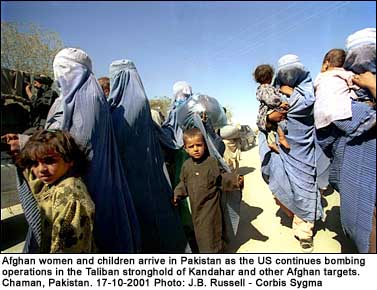 From
the beginning of this crisis humanitarian organizations have warned
of a potentially catastrophic humanitarian disaster looming on the other
side of the border. After more than 20 years of war and four years of
severe drought there are already over 2 million refugees in Pakistan
and many more in other neighboring countries. For most Afghans still
in the country, living conditions were already dire, teetering on widespread
famine. With winter approaching, aid organizations forced to leave the
country and US retaliatory attacks looming overhead, sustainable existence
for Afghans seemed to be pushed over the edge. From
the beginning of this crisis humanitarian organizations have warned
of a potentially catastrophic humanitarian disaster looming on the other
side of the border. After more than 20 years of war and four years of
severe drought there are already over 2 million refugees in Pakistan
and many more in other neighboring countries. For most Afghans still
in the country, living conditions were already dire, teetering on widespread
famine. With winter approaching, aid organizations forced to leave the
country and US retaliatory attacks looming overhead, sustainable existence
for Afghans seemed to be pushed over the edge.
Despite reports of huge numbers of people on the move within the country,
primarily fleeing the cities, large numbers of refugees flooding into
Pakistan failed to materialize. Concerned about yet another wave of
refugees, Pakistan closed its borders. While some refugees did manage
to trickle through the mountains and remote border crossings, they quickly
blended into the local refugee population to avoid being repatriated.
Now that the bombardment of Afghanistan is into its second week and
the city of Kandahar, the Taliban's headquarters just opposite Quetta,
is being heavily targeted we heard that larger numbers of refugees were
crossing the border at Chaman.
After the habitual negotiations with the local security forces, a small
group of journalists managed to arrange an escorted convoy to the Chaman
border post. We set out on the three hour trip across a desolate, arid
landscape to the border. We passed abandoned refugee camps from previous
crises and the smoking chimney towers of brick making kilns. At the
border crossing we once again negotiated with border guards to assure
them that we were authorized to be there and to photograph. We were
able to work for about an hour before being ushered away for the three
hour journey back to Quetta. During the brief stay, we witnessed a steady
stream of Afghans coming into Pakistan. The majority were children and
women, dressed in the traditional burqa required by the Taliban regime.
Burqas cover women from head to toe, rendering them anonymous blue ghosts.
Many men bring their families out of Afghanistan and return to guard
family homes against looting or are forcibly conscripted by the Taliban
to fight against US forces. Despite the fact that the border remains
officially closed, the refugees told us that they paid baksheesh to
the border guards and were allowed to cross the border where they loaded
all their belongings, including livestock sometimes, into the backs
of local pick-up trucks to take them down to Quetta. Those who don't
have the means to get to the border or to buy their way across attempt
to go to relatives in the slightly more secure countryside, but nevertheless
are caught in the crossfire of Taliban repression, draught and the war
on terrorism.
--
J.B. Russell, Photojournalist
e-mail: RoadtoNowhere@compuserve.com
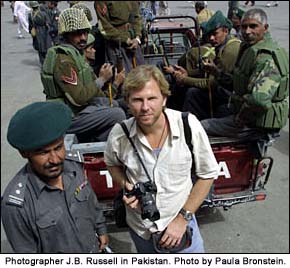 I
am a photojournalist and this is what I do - documenting contemporary
history and critical humanitarian issues. I do it because I love photography,
I think it is imperative that the world is informed and aware about
the condition of humanity on our planet and images are one of the best
ways of conveying this reality to a wider public. I hope that in a small
way my work and the collective work of all journalist will contribute
to better understanding and eventual resolution of the many conflicts
and injustices that exist in our societies. At times this entails considerable
personal and financial risks. Like all independent photographers, especially
in the current economic environment of the editorial world, it is extremely
difficult to make a decent living. However, I've been doing this long
enough and have a good enough relationship with my editors and the magazines
that I can usually make it pay. Noone pursues this profession to make
money though. On the other hand, the experiences that I have and the
people that I meet while doing this work are more valuable and add more
personal wealth to my life than any potential financial rewards could
ever provide. Perhaps I'm crazy, but I think it's worth it. I'd like
to thank Kodak France for generously providing the film for this project. I
am a photojournalist and this is what I do - documenting contemporary
history and critical humanitarian issues. I do it because I love photography,
I think it is imperative that the world is informed and aware about
the condition of humanity on our planet and images are one of the best
ways of conveying this reality to a wider public. I hope that in a small
way my work and the collective work of all journalist will contribute
to better understanding and eventual resolution of the many conflicts
and injustices that exist in our societies. At times this entails considerable
personal and financial risks. Like all independent photographers, especially
in the current economic environment of the editorial world, it is extremely
difficult to make a decent living. However, I've been doing this long
enough and have a good enough relationship with my editors and the magazines
that I can usually make it pay. Noone pursues this profession to make
money though. On the other hand, the experiences that I have and the
people that I meet while doing this work are more valuable and add more
personal wealth to my life than any potential financial rewards could
ever provide. Perhaps I'm crazy, but I think it's worth it. I'd like
to thank Kodak France for generously providing the film for this project.
|